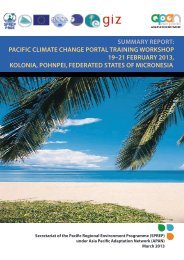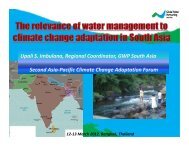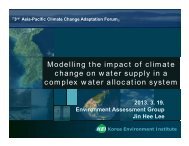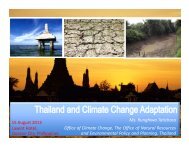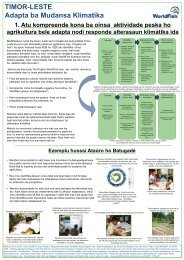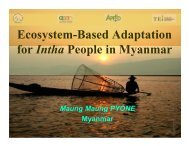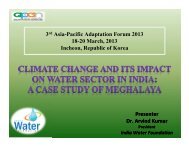PDF file (2.44 MB) - Asia Pacific Adaptation Network
PDF file (2.44 MB) - Asia Pacific Adaptation Network
PDF file (2.44 MB) - Asia Pacific Adaptation Network
Create successful ePaper yourself
Turn your PDF publications into a flip-book with our unique Google optimized e-Paper software.
Parallel Sessions 4: Systems and Tools for Analysing Climate Change Impacts and Vulnerability47Parallel Sessions 4SYSTEMS and TOOLS for ANALYSINGCLIMATE CHANGE IMPACTS and VULNERABILITYParallel Session 4AEliciting Factors Affecting Fish Kill Events in Taal Lakethrough Participatory Approaches:A Tool for the Development of a Predictive Fish Kill ModelDamasa B. Magcale-Macandog, PhDProfessor of Biological Sciences, University of the Philippines Los BañosTaal Lake is an economically important resource that provides about 40% of the fish requirements ofMetro Manila, Philippines and most towns surrounding the lake (CALABARZON region). Aside from themore common tilapia (Tilapia nilotica) and milkfish grown in fish cages, Taal Lake is home to severalendemic fish species.Fish kill has been observed as an annual occurrence in the lake. Occasionally, however, fish killhappens on a massive scale due to a confluence of factors. For instance, Taal Lake became a virtualgraveyard of about 2,000 MT of fish in 2011 – with close to PhP 60 M worth of combined losses in fourof the hardest hit towns. This prompted the Department of Science and Technology (DOST) to providea research grant for the development of an early warning system to reduce such losses.Dr. Macandog’s team documented local ecological knowledge of fishing communities and keyinformants on the fish kill phenomenon using participatory rural appraisal or PRA tools, namely,community timeline, lake and land use mapping, causal and solutions mapping, plus strengthsweaknesses-opportunities-threats(SWOT) analysis. Along with other relevant information, e.g., lakewater quality from the regional monitoring station of the Bureau of Fisheries and Aquatic Resources(BFAR) and weather data from the national weather station PAGASA, the research team aims todevelop a predictive fish kill model as a basis for the early warning system.Factors contributory to fish kill include both climate- and nonclimate- related factors, as follows:• Lake pollution was identified by the community as a major cause of fish kill in the lake.Such pollution comes from improper aquaculture practices, domestic and solid waste, andagricultural and commercial waste, among others.• Other causes that the locals enumerated include change in wind direction, greenish water,long duration of calm or stagnant-like water condition, and seasonal changes.ooSoutheasterly wind or hanging Salatan from April to May is characterized by very calmwaters and high water temperature, which influences lake overturn and is known to havecontributed to the May-June 2011 fish kill in Taal Lake.Southwesterly wind or hanging Habagat from May to Sept brings the most unstableequatorial air (hence, the highest temperature fluctuations), causing cloudy and rainymonths and typhoon events. Such weather disturbances deprive fish cages of aeration.Most of the severe fish kills occur during this period.International Conference on Climate Change Impactsand <strong>Adaptation</strong> for Food and Environmental SecurityConference Summary Report





